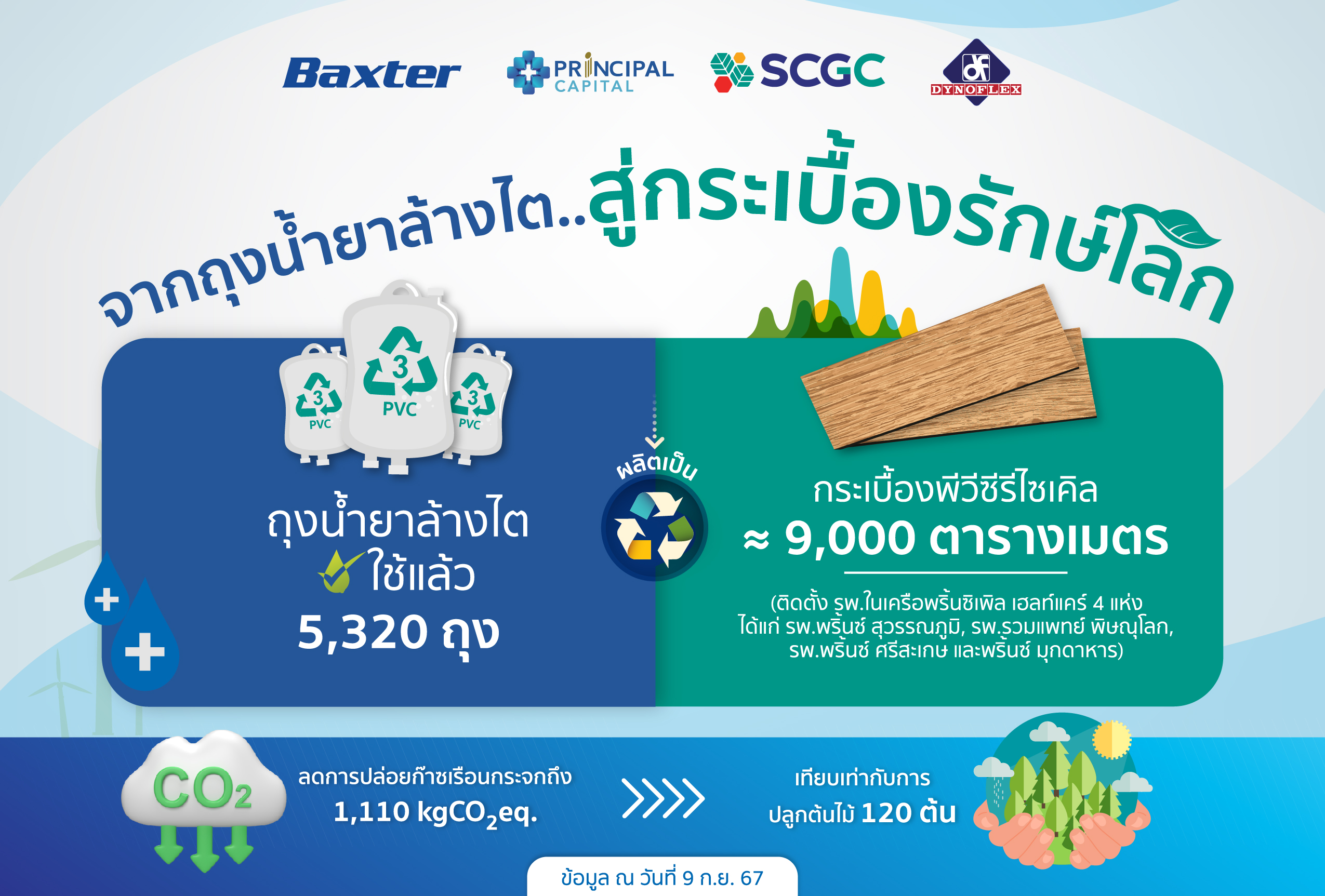Waste and Hazardous Material Management
Principal Capital Public Company Limited is committed to enhancing the efficiency and systematic management of waste and hazardous materials across all hospitals in its network. This effort aligns with legal regulations and international environmental best practices. The objective is to minimize environmental impacts, reduce burdens on surrounding communities, and promote resource efficiency in line with the Circular Economy approach.
To achieve these goals, the company has implemented policies applicable to all hospitals within its network, including:
- Hazardous Waste Management Policy
- General Waste Management Policy
- Infection Control Policy in Hospitals
These policies aim to reduce hazardous contamination in the environment and communities, minimize the volume of environmentally harmful waste, and develop practical management systems that can be applied at all operational levels.
Waste Management Commitment
The company pledges to manage waste comprehensively—from the source of generation to final disposal—while encouraging active participation from employees, communities, and partners to create a lasting positive impact on both the healthcare system and the environment. Key actions include:
- Monitor and ensure that all waste and hazardous mateiral management comply with applicable laws, regulations, and relevant requirements
- Regularly developing and reviewingGeneral Waste Management Policyto cover general, infectious, hazardous, and recyclable waste
- Implementingwaste segregation systems at the sourcein every department to ensure proper and effective waste classification
- Setting and monitoringtargets for waste reduction and increased recycling rates in all hospitals
- Encourage and support its suppliers to adopt waste management practices that align with the company’s principles, through collaboration in reducing waste from procurement processes, using reusable packaging, and implementing appropriate waste separation at source.
- Expandingcircular economy initiatives such as the recycling of used blister packs and medical materials in collaboration with expert partners
- ExpandingRaising awareness at both organizational and community levels through campaigns, engagement activities, and partnerships with external networks
Waste and Hazardous Material Management Target
- Develop a comprehensive waste management system that covers all waste types—including general waste, infectious waste, hazardous waste, recyclable waste, and food waste—under clear policies and practices in alignment with legal requirements.
- Promote waste segregation at source, with an emphasis on separating infectious waste from recyclable materials to enhance management efficiency and reduce contamination risks.
- Expand the adoption of the Circular Economy within the organization by using products made from recycled materials and properly recycling used medical materials.
- Raise awareness among employees and communities through ongoing campaigns, training programs, and partnerships with external organizations.
- Encourage active participation from all hospitals in the network in collaborative waste management initiatives with external organizations.
- Increase the proportion of recycled waste and reduce general waste, aiming for a 50:50 ratio of general to recycled waste across all hospitals by 2030, to improve resource efficiency and reduce dependency on landfill disposal.
- Reduce the amount of infectious waste per bed to no more than 0.4 kilograms per bed per day by 2030, in accordance with the World Health Organization (WHO) guidelines for healthcare facilities.
- Expand the food waste segregation system to cover all hospitals in the network by 2025, starting with 4 pilot hospitals in 2024, to reduce organic waste and promote its reuse (e.g., animal feed or composting).
Performance Over the Past 3 Years
| Indicator | 2022 | 2023 | 2024 |
|---|---|---|---|
| Number of hospitals within the network | 12 | 14 | 15 |
| Waste and hazardous material management plan |
Waste management aligned with hospital operation standards; roadmap toward Zero Waste to Landfill in all hospitals initiated. Already implemented at Princ Hospital Suvarnabhumi, Princ Hospital Paknampo 1 & 2, and Princ Hospital Sakon Nakhon. |
||
| Policy and guidelines on infectious waste management | The company has a formal policy and operating procedures integrated into its overall waste disposal policy. Infectious waste is classified into 3 categories: sharp, non-sharp, and liquid waste. Each hospital's infection control or quality center tailors procedures in line with this policy. | ||
| General waste (kg) | 401,404.03 | 933,975.48 | 707,455.03 |
| General waste per patient (kg/person/year) | 0.36 | 1.09 | 0.74 |
| RDF (Refuse-Derived Fuel) waste (kg) | 173,630.00 | 308,879.90 | 740,455.90 |
| Infectious waste (kg) | 647,698.42 | 369,892.28 | 396,707.02 |
| Infectious waste per patient (kg/person/year) | 0.59 | 0.43 | 0.41 |
|
Infectious waste per bed (kg/bed/year)
* Target 0.4 kg/bed/year |
1.08 | 1.64 | 1.74 |
| Hazardous waste (kg) | 7,291.61 | 10,892.73 | 14,952.66 |
| Hazardous waste per patient (kg/person/year) | 0.01 | 0.01 | 0.02 |
| Recyclable waste (kg) | 92,431.31 | 159,809.35 | 192,438.96 |
| Recyclable waste per patient (kg/person/year) | 0.08 | 0.19 | 0.20 |
|
General waste to recyclable waste ratio
* Target 50:50 |
87:13 | 81:19 | 79:21 |
| Food waste (kg) | Not tracked; initial guidelines in place as part of overall waste policy | 74,390 | |





